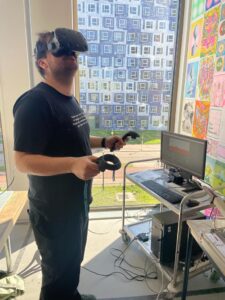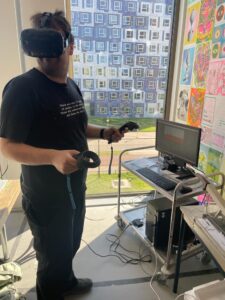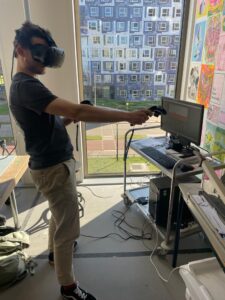Premise:
Building an application which assists students to save money for travelling by including virtual reality experiences as incentives to keep them engaged with the money-saving process
Synopsis:
Travelling is an activity which many people appreciate. It has a number of benefits for well-being of people. Despite that, around half of the population can’t travel due to financial reasons. People express a desire to save money for travelling and travel more. By putting a small amount of money daily people would be able to save a large amount of money for their desired trip. Creating an application which assists people in creating money-saving routines. Building new routines is a complex progress therefore visuals can be used to motivate people and reward them in a routine creation process. Virtual reality can be used to motivate people save money for travelling. People seeing virtual visuals as if they are surrounded by their desired environment (country which they wish to visit) might trigger their motivation to keep engaging with money saving. With this project I am exploring how VR might affect users’ willingness to save money for reaching their travelling goals.
Problem statement:
Travelling is beneficial for people: it improves their mental state and health and broadens their horizons, (Vandenwyngaert, 2020). For students travelling improves their academic performance and stimulates their self-growth (Kelly & Kelly, 2021). Majority of people have a desire to travel. Around half of adults, as well as young adults, as students, are unable to travel since they lack the funds (Richter, 2022). Such problem: people wanting to travel but not having the ability to afford it could be solved with a help of an application which assists people in reaching their vacation goals. Successful way to achieve goals is to create new daily routines which lead towards accomplishing the goal.
Solution:
Designing an application which assists students to save money for travelling by providing a personalised money-saving plan, so the students could put aside a small amount of money daily in order to reach their vacation goals. Implementing virtual reality as an addition to the application, as a mean to keep students engaged with money-saving process. The more days student puts aside money for savings, the more realistic VR experiences he will be able to see. VR environment represents a country where the student wants to travel: the more money is saved, the more realistic he can see the location that he wants to go.
Virtual reality:
Visuals impact people’s psychology and are able to manipulate their behaviours (Wojda, 2022b). Professor Mannecke states that more realistic images (vidid, interactive) stimulate bigger user response and have a higher potential of affecting people (Want Kids to Eat Healthier? Don’t Tell Them, Show Them, News Service, Iowa State University, 2013). Since visuals, especially realistic visuals have such effect on people, VR is a tool which can be used to trigger a certain behaviour in people effectively. VR technology in the past research was explored and it was discovered that people were more motivated to engage with the product if it featured VR (Han & Yin, 2021b), (Kim & Hall, 2019c). With a goal to trigger people perform daily money-saving actions, VR will be used as a reward to keep students engaged with the money-saving process.
Scope of research:
This project is mainly focused on exploring technology of virtual reality and it’s capabilities to affect students’ willingness to engage with money-saving process
Preparation:
Program Cinema3D was chosen as a mean to create 3D objects of virtual environment. Unity program was picked to create virtual environments which were later connected to HTC Vive VR headset through which the environments could be viewed. Working on this project was around half the time performed from home and half the time from Makerspace at the HU. HTC Vive VR headset could be used at the Makerspace so I had the ability to view the created environments through the VR glasses.

Designing the prototype:
Firstly one participant of the testing was selected. The participant belongs to the target audience- student who want to save money for travelling. Student was asked which country he wants to travel the most and Australian outback was his answer. My project focuses on creating VR prototype which represents a specific country that the student wants to see therefore his answer determined which environment I will be creating.
Online looking for visuals that display Australian outback to get an impression on how the environment should look like.

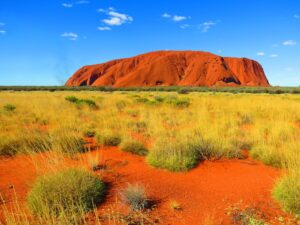
1st version of the prototype
Beginning to create a scene which will represent Australian outback in Cinema 4D program. Firstly creating a realistic ground texture, adding the road sign, plants.


Testing
Conducting prototype testing with the participant which belong to the target audience- a student who wants to travel. The session was carried out in Makerspace, transferring 3D scene to Unity. There were some issues with displaying cinema4D objects in Unity. Therefore I had to recreate the scene in Unity. Connecting HTC Vive headset to Stream, so it would automatically connect to Unity. Displaying the prototype and asking user questions related to the visual appeal of the scene and related to how realistically the scene represents Australian outbacks.
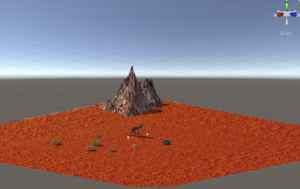
Feedback
Feedback gathered gave me important insights. In the current prototype ground is rough and curved but floor of the classroom (location of testing) is flat. Such inconsistency is confusing and makes participant confused how to walk (he feels flat surface below his feet sees curved ground through VR glasses). Participant also expressed feeling strange about the visuals since there is no boundaries in the horizon- when he looks around he sees emptiness and this disturbs him to perceive the environment as realistic.
Changes
Gathered feedback gave me ideas for improvement. Such changes should be made:
-Make the ground flat
-Create some boundaries for the scene (e.g. high objects as mountains, buildings)
-Add more objects, realistic textures
2nd version
Feedback
Participant felt restricted in the VR environment. The space he sees is huge and gives the feeling that it is possible to walk around, but testing done in a small restricted space (a part in Makerspace classroom, around 2 square meters). Therefore he couldn’t walk further and see more of the environment. During testing sessions I had to give some context information about what the application represents (what problem it solves) and I noticed that participant was confused to understand the concept fully. I decided to create a mobile app prototype to display the full idea better. Participant also expressed that more realistic materials should be picked in order to make the environment more appealing. He also noticed that he can do not much more except of standing and looking around.
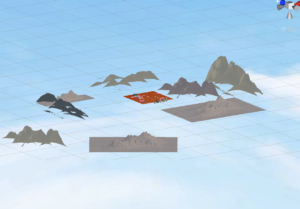
Changes
-Adding teleport so the user can move in the environment
-Add interactions
-Create mobile prototype to give more context
3rd version (interactions, testing with mobile application present)
Adding interactions as teleport and object picking/ throwing. Interactivity could be done with a help of HTC Vive hand controllers. Created stones which participant could pick and throw- the bigger stone was, the “heavier” it felt (took longer to lift it to the air and it took longer time before it lands. Adding teleport which allowed to move around the environment.
.
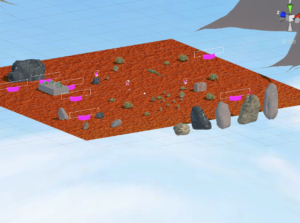
Feedback:
Participants (this time two) appreciated interactions, especially rock throwing. As well as mobile prototype gave more clarity and convinced that VR solution is suitable in this case.
Conclusion
VR technology is fun and interesting to work with. I believe that for the problem I have VR technology could be a good way to increase user’s engagement with the system. I discovered that it is a technology which is highly time-consuming. In order to create realistic and beautiful VR experience a lot of details are important. Picking textures was the most complicated part and i am not too satisfied with the end result. In order to create a realistic landscape every texture should be realistic and creating them is time-consuming. Unity is a program which provides a lot of possibilities but is also a complex one and can take time to learn the basic features.
Participants were engaged with the experiences, especially once interactions were introduced. After testing rounds they were asked if they are willing to put money aside to travel to that country. After 1st testing (basic environment) their motivation to save money wasn’t triggered, but after 2nd and 3rd testing rounds they felt more willing to save money to go to that country.\
References
Kelly, S., & Kelly, S. (2021, August 2). Top Ten Social Effects of Student Travel. Nations Classroom. https://www.nationsclassroomtours.com/blog/top-ten-social-effects-of-student-travel/#:~:text=More%20intellectual%20curiosity%20(55%25%20of,explore%20(60%25%20of%20respondents)
Want kids to eat healthier? Don’t tell them, show them • News Service • Iowa State University. (2013, July 18). https://www.news.iastate.edu/news/2013/07/18/digitaldisplays
Wojda, K. (2022b, January 6). Two Studies Show How Visuals Impact Decision Making – Spectrio. Spectrio. https://www.spectrio.com/marketing/two-studies-show-how-visuals-impact-decision-making/
Han, Y., & Yin, W. H. (2021c). The effect of multimedia teaching platform based on virtual technology on students’ English learning motivation. International Journal of Electrical Engineering Education, 002072092098849. https://doi.org/10.1177/0020720920988495
Kim, M. K., & Hall, C. M. (2019c). A hedonic motivation model in virtual reality tourism: Comparing visitors and non-visitors. International Journal of Information Management, 46, 236–249. https://doi.org/10.1016/j.ijinfomgt.2018.11.016
Vanden Wyngaert, K., Van Biesen, W., Eloot, S., Van Craenenbroeck, A. H., Calders, P., & Holvoet, E. (2022c). The importance of physical performance in the assessment of patients on haemodialysis: A survival analysis. PLOS ONE, 17(5), e0268115. https://doi.org/10.1371/journal.pone.0268115
